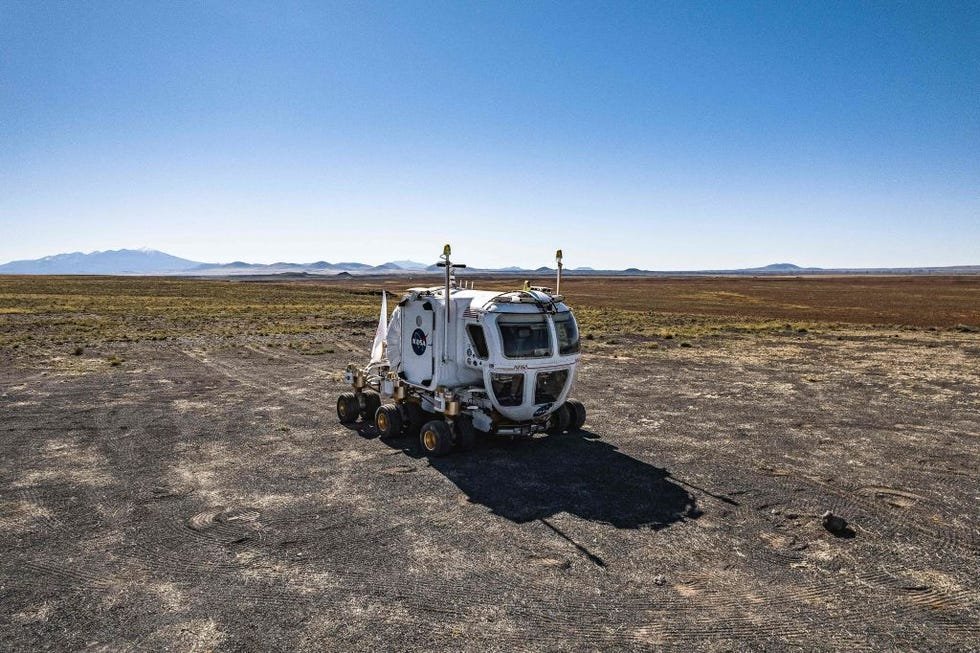To prepare for upcoming Artemis missions, NASA conducted intensive field tests of a pressurized lunar rover prototype in the rugged terrain north of Flagstaff, Arizona—especially in the San Francisco Volcanic Field and Black Point Lava Flow. This week-long exercise simulated lunar operations, focusing on rover functionality, crew endurance, geology sampling, and equipment reliability.
🚀 Why Arizona?
Northern Arizona’s desert environment, with its volcanic rock formations, craters, and minimal light pollution, presents an ideal analogue for the lunar South Pole. The region’s challenging terrain helps simulate the conditions astronauts will face on the Moon spacenews.com+8nasa.gov+8nasa.gov+8.
What Was Tested
- Pressurized Rover Operations
Crews, including astronauts and engineers from NASA and JAXA, lived and worked inside the rover for up to 48 hours, venturing out for simulated moonwalks while wearing mockup spacesuits popularmechanics.com+2nasa.gov+2popularmechanics.com+2news.asu.edu+8nasa.gov+8nasa.gov+8. - Geology Fieldwork
During four separate moonwalks, astronauts collected soil and rock samples, following geologic maps prepared by the science team to mimic lunar missions usgs.gov+2nasa.gov+2nasa.gov+2. - Technology Trials
Tests included mobility over rough volcanic surfaces using advanced wheel and suspension systems, communications via 4G cellular setups, and navigation aids like Augmented Reality and lighting beacons en.wikipedia.org+4nasa.gov+4nasa.gov+4.
Insights & Achievements
- Rover Agility & Design Feedback
The rover demonstrated rock-climbing, sideways driving, and spinning-in-place maneuvers—critical capabilities for lunar traverses phys.org+212news.com+2nasa.gov+2. Crew feedback on cabin layout, controls, and life-support systems guided iterative design improvements en.wikipedia.org+10popularmechanics.com+10popularmechanics.com+10. - Crew Endurance in Simulated Missions
Living and working in rover-like conditions revealed insights into human factors, from space suit functionality to onboard comfort during extended sorties pbs.org+11nasa.gov+11nasa.gov+11. - Operational Lessons
Practice with docking protocols, emergency handling, and live mission-control coordination refined systems readiness for complex lunar tasks nasa.gov.
NASA & JAXA Collaboration
These tests are part of the Desert RATS (Research and Technology Studies) program—annual analog missions that began in the late 1990s. NASA works jointly with JAXA for pressurized-rover testing under the D-RATS and JETT frameworks foxweather.com+12en.wikipedia.org+12nasa.gov+12.
The Asian agency contributes crew members and engineers, enabling bilateral refinement of rover design and operational protocols—critical preparation for the planned Artemis VII mission in the late 2020s popularmechanics.com+3popularmechanics.com+3popularmechanics.com+3.
What’s Next
- Rover Improvements: Based on field feedback, engineers will refine wheel designs, suspension, cabin ergonomics, and autonomous systems.
- Future Field Tests: New trials are scheduled, potentially expanding mission duration and testing additional Artemis-relevant tech.
- Continued Analogue Simulations: Desert RATS remains a key part of NASA’s iterative testing strategy, mirroring real lunar challenges to ensure mission resilience.
NASA’s Arizona tests underscore a methodical, risk-managed approach to building lunar-capable rovers. By blending crew experience, engineering validation, and science operations, these simulations help ensure Artemis astronauts are ready for extended exploration and in-situ science on the Moon.









